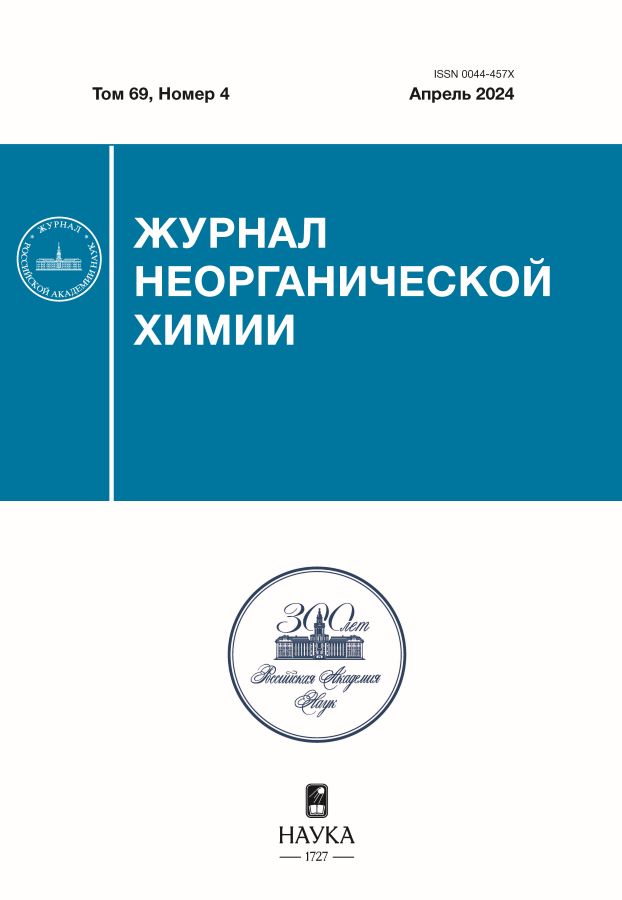Features of the Structure and Thermal Properties of LnBWO6 (La = Ln, La0.999Nd0.001, La0.99Gd0.01) Synthesized by the Sol-Gel Method
- 作者: Krut’ko V.A.1, Komova M.G.1, Svetogorov R.D.2, Khoroshilov A.V.1, Efimov N.N.1, Ugolkova E.A.1
-
隶属关系:
- Kurnakov Institute of General and Inorganic Chemistry of the Russian Academy of Sciences
- National Research Center “Kurchatov Institute”
- 期: 卷 69, 编号 4 (2024)
- 页面: 507-516
- 栏目: СИНТЕЗ И СВОЙСТВА НЕОРГАНИЧЕСКИХ СОЕДИНЕНИЙ
- URL: https://kazanmedjournal.ru/0044-457X/article/view/666564
- DOI: https://doi.org/10.31857/S0044457X24040066
- EDN: https://elibrary.ru/ZYKEIT
- ID: 666564
如何引用文章
详细
Borate tungstates LnBWO6 (Ln = La, La0.999Nd0.001, La0.99Gd0.01) were synthesized by the Pechini method with subsequent annealing of intermediates. They were analyzed by X-ray diffraction (XRD) and DSC methods. Crystallographic parameters of synthesized LnBWO6 were refined by powder X-ray diffraction in two systems: monoclinic, space group P21, and orthorhombic, space group P222. The presence of reversible first-order phase transitions in synthesized LnBWO6 was detected using the DSC method, and the temperatures and enthalpies of phase transformations were determined. It has been shown that Nd3+ and Gd3+ dopants lowers the L- → H- phase transition temperature of LaBWO6. According to experimental electron paramagnetic resonance (EPR) data gadolinium has two independent positions in the La0.99Gd0.01BWO6 structure.
全文:
作者简介
V. Krut’ko
Kurnakov Institute of General and Inorganic Chemistry of the Russian Academy of Sciences
编辑信件的主要联系方式.
Email: kroutko@igic.ras.ru
俄罗斯联邦, Moscow, 119991
M. Komova
Kurnakov Institute of General and Inorganic Chemistry of the Russian Academy of Sciences
Email: kroutko@igic.ras.ru
俄罗斯联邦, Moscow, 119991
R. Svetogorov
National Research Center “Kurchatov Institute”
Email: kroutko@igic.ras.ru
俄罗斯联邦, Moscow, 123182
A. Khoroshilov
Kurnakov Institute of General and Inorganic Chemistry of the Russian Academy of Sciences
Email: kroutko@igic.ras.ru
俄罗斯联邦, Moscow, 119991
N. Efimov
Kurnakov Institute of General and Inorganic Chemistry of the Russian Academy of Sciences
Email: kroutko@igic.ras.ru
俄罗斯联邦, Moscow, 119991
E. Ugolkova
Kurnakov Institute of General and Inorganic Chemistry of the Russian Academy of Sciences
Email: kroutko@igic.ras.ru
俄罗斯联邦, Moscow, 119991
参考
- Lu-Ling Li, Xiao-Yu Yue, Wen-Jing Zhang et al. // Chin. Phys. B. 2021. V. 30. P. 916. https://doi.org/10.1088/1674-1056/abf 916
- Dai J., Zhao D., Zhang R.J. et al. //J. Alloys Compd. 2022. P. 891. https://doi.org/ 10.1016/j.jallcom.2021.161973
- Jin X.Y., Xie Y., Tang R. et al. //J. Alloys Compd. 2022. P. 899. https://doi.org/10.1016/j.jallcom.2021.162739
- Flavián D., Nagl J., Hayashida S. et al. // Phys. Rev. B. 2023. V. 107. P. 174406. https://doi.org/10.1103/PhysRevB.107.174406
- Крутько В.А., Комова М.Г., Поминова Д.В. // Неорган. материалы. 2018. Т. 54. № 11. С. 1210. https://doi.org/10.1134/S0002337X1811009X
- Sun C.X., Lin Z.B., Zhang L.Z. et al. //Chin. J. Struct. Chem. 2013. V. 32. P. 1088. https://www.researchgate.net/publication/283843691
- Kaminskii A.A. // Quantum Electronics. 2019. V. 49. P. 377. https://doi.org/10.1070/QEL16980
- Xiong F.B., Chen H., Lin H.F. et al. // J. Lumin. 2019. V. 209. P. 89. https://doi.org/10.1016/j.jlumin.2019.01.034]
- Крутько В.А., Комова М.Г., Поминова Д.В. и др. //Неорган. материалы. 2023. Т. 59. № 9. https://doi.org/10.31857/S0002337X23090087
- Li B., Huang X., Guo H. et al. // Dyes and Pigments. 2018. V. 150. P. 67. https:// doi.org/10.1016/j.dyepig.2017.11.003
- Xiong F.B., Lin H.F., Ma Z. et al. // Opt. Mater. 2017. V. 66. P. 474. https://doi.org/10.1016/j.optmat.2017.03.002
- Gancheva M., Aleksandrov L., Iordanova R. et al. // J. Chem. Technol. Metallurgy. 2015. V. 50. P. 467.
- Aleksandrov L., Komatsu T., Shinozaki K. et al. // J. Non-Cryst. Solids. 2015. V. 429. P. 171. https://doi.org/10.1016/j.jnoncrysol.2015.09.004
- Zhu D., Mu Z. // Displays. 2014. V. 35. P. 261. https://doi.org/10.1016/j.displa.2014.09.005
- Aleksandrov L., Iordanova R., Dimitriev Y. et al. // Opt. Mater. 2014. V. 36. P. 1366. https:// doi.org/10.1016/j.optmat.2014.03.031
- Huang Y., Seo H.J. // Mater. Lett. 2012. V. 84. P.107. https://doi.org/10.1016/j.matlet.2012.06.051
- Джуринский Б.Ф., Резник Е.М., Тананаев И.В. // Журн. неорган. химии. 1980. Т. 25. № 11. С. 2981.
- Палкина К.К., Сайфуддинов В.З., Кузнецов В.Г. и др. // Журн. неорган. химии. 1979. Т. 24. № 5. С. 1193.
- Джуринский Б.Ф., Лысанова Г.В. // Журн. неорган. химии. 1998. Т. 43. № 12. С. 2065.
- Aleksandrov L., Komatsu T., Iordanova R. et al. //Opt. Mater. 2011. V. 34. P. 201. https://doi.org/10.1016/j.optmat.2011.08.002
- Becker P., van der Wolf B., Bohat´y L. et al. //Laser Phys. Lett. 2008. V. 5. P. 737. https://doi.org/10.1002/lapl.200810056
- Zhao W., Zhang L., Wang G. et al. // Opt. Mater. 2009. V. 31. P. 849. https://doi.org/10.1016/j.optmat.2008.09.010
- Svetogorov R.D., Dorovatovskii P.V., Lazarenko V.A. // Cryst. Res. Technol. 2020. V. 55. № 5. P. 1900184. https://doi.org/10.1002/crat.201900184
- Светогоров Р.Д. // Авторское свидетельство о государственной регистрации права № 2018660965.
- Petricek V., Dusek M., Palatinus L. // Z. Kristallogr. 2014. V. 229. № 5. P. 345. https://doi.org/10.1515/zkri-2014-1737
- Shannon R.D. // Acta Crystallogr., Sect. A. 1976. V. 32. P. 751.
- Абрагам А., Блини Б. Электронный парамагнитный резонанс переходных ионов. Пер. с англ. М.: Мир, 1972. Т. 1. 651 с.; Т. 2. 349 с.
- lford G.G., Belford R.L., Burkhaven J.F. // J. Magn. Reson. 1973. V. 11. P. 251.
补充文件
















